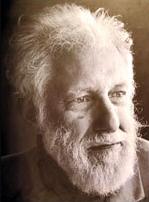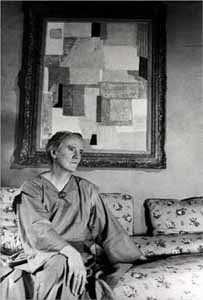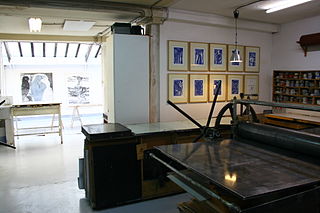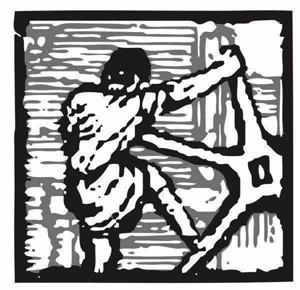
Printmaking is the process of creating artworks by printing, normally on paper, but also on fabric, wood, metal, and other surfaces. "Traditional printmaking" normally covers only the process of creating prints using a hand processed technique, rather than a photographic reproduction of a visual artwork which would be printed using an electronic machine ; however, there is some cross-over between traditional and digital printmaking, including risograph.

Jacques Hnizdovsky, (1915–1985) was a Ukrainian-American painter, printmaker, graphic designer, illustrator and sculptor.

Stanley William Hayter was an English painter and master printmaker associated in the 1930s with surrealism and from 1940 onward with abstract expressionism. Regarded as one of the most significant printmakers of the 20th century, in 1927 Hayter founded the legendary Atelier 17 studio in Paris. Since his death in 1988, it has been known as Atelier Contrepoint. Among the artists who frequented the atelier were Pablo Picasso, Alberto Giacometti, Joan Miró, Alexander Calder, Marc Chagall, Nemesio Antúnez, Jackson Pollock, Mark Rothko, Wassily Kandinsky, Mauricio Lasansky, K.R.H. Sonderborg, Flora Blanc, Carl Heywood, and Catherine Yarrow.

Julian Otto Trevelyan was an English artist and poet.
Atelier 17 was an art school and studio that was influential in the teaching and promotion of printmaking in the 20th century. Originally located in Paris, the studio relocated to New York during the years surrounding World War II. It moved back to Paris in 1950.

Krishna Reddy was an Indian master printmaker, sculptor, and teacher. He was considered a master intaglio printer and known for viscosity printing.

Anne Ryan (1889–1954) was an American Abstract Expressionist artist associated with the New York School. Her first contact with the New York City avant-garde came in 1941 when she joined the Atelier 17, a famous printmaking workshop that the British artist Stanley William Hayter had established in Paris in the 1930s and then brought to New York when France fell to the Nazis. The great turning point in Ryan's development occurred after the war, in 1948. She was 57 years old when she saw the collages of Kurt Schwitters at the Rose Fried Gallery, in New York City, in 1948. She right away dedicated herself to this newly discovered medium. Since Anne Ryan was a poet, according to Deborah Solomon, in Kurt Schwitters’s collages “she recognized the visual equivalent of her sonnets – discrete images packed together in an extremely compressed space.” When six years later Ryan died, her work in this medium numbered over 400 pieces.
Józef Hecht, also known as Joseph Hecht, was a printmaker and painter. Born and educated in Poland, he made Paris his base from 1920. Trained in classical engraving techniques, Hecht was a founder of "Atelier 17", and had a profound influence on 20th-century printmakers.

Seong Moy was an American painter and printmaker. Moy was born in a small town outside of Canton, China; he emigrated to the United States at the age of 10 in 1931, and joined other members of his family who had settled in St. Paul, Minnesota. During this time, Moy attended school during the day, and trained in his uncle's restaurant as an assistant chef when not in school. In 1934, Moy was introduced to art classes at the WPA Federal Art Project School through a friend. For the next few years, Moy studied art first at the Federal Art Project, and later at the St. Paul School of Art under Cameron Booth, and the WPA Graphic Workshop at the Walker Art Center in Minneapolis, MN. Advisors recognized his talent and permitted him to take more classes while maintaining a job.
Peter Grippe was an American sculptor, printmaker, and painter. As a sculptor, he worked in bronze, terracotta, wire, plaster, and found objects. His "Monument to Hiroshima" series (1963) used found objects cast in bronze sculptures to evoke the chaotic humanity of the Japanese city after its incineration by atomic bomb. Other Grippe Surrealist sculptural works address less warlike themes, including that of city life. However, his expertise extended beyond sculpture to ink drawings, watercolor painting, and printmaking (intaglio). He joined and later directed Atelier 17, the intaglio studio founded in London and moved to New York at the beginning of World War II by its founder, Stanley William Hayter. Today, Grippe's 21 Etchings and Poems, a part of the permanent collection at the Davis Museum and Cultural Center at Wellesley College in Wellesley, Massachusetts, is available as part of the museum's virtual collection.

Michael Woolworth is a master printer of American origin, living and working in Paris. He makes original editions with contemporary artists. His atelier specializes exclusively in printing techniques on hand presses: stone lithography, woodcut, monotype, linocut, etching and multiples.

Letterio "Leo" Calapai was an American artist and educator, who identified with the Realism movement. Calapai completed works of art for the Federal Arts Project, which was organized by the Works Progress Administration in the late 1930s and early 1940s.

The Society of American Graphic Artists (SAGA) is a not for profit national fine arts organization serving professional artists in the field of printmaking. SAGA provides its members with exhibition, reviews and networking opportunities in the New York City area and, in addition to various substantial exhibition prizes, many purchase awards allow SAGA members to be included in major U.S. museum collections.
Marian Korn (1914–1987) was a Czechoslovakian printmaker. She was born February 15, 1914, in Chomutov, Austro-Hungarian Empire. In 1931, she moved to Prague, and in 1931, she graduated from the Women's College of Prague. She married in 1938, and emigrated to the United States in 1939. In 1949, she moved to Tokyo with her entrepreneur husband Frank and two daughters.
Clare Romano (1922–2017) was an internationally known American printmaker and painter with works in the Metropolitan Museum of Art, the Museum of Modern Art, the Smithsonian American Art Museum, the Cooper Hewitt, Smithsonian Design Museum and other major collections. As an advocate, innovator, and educator in the field of printmaking, Romano has co-authored in collaboration with her husband, John Ross, The Complete Printmaker (1972), The Complete Collagraph (1980), and several other printmaking manuals that have become standard texts for universities. They founded their High Tide Press for artists books in 1991.
James Lesesne Wells was an African American graphic artist, print-maker, and painter associated with the Harlem Renaissance. He was an influential art professor at Howard University from 1929 to 1968 and is considered a pioneer in modern art education.

Armin Landeck (1905-1984) was an American printmaker and educator.
Master printmakers or master printers are specialized technicians who hand-print editions of works of an artist in printmaking. Master printmakers often own and/or operate their own printmaking studio or print shop. Business activities of a Master printshop may include: publishing and printing services, educational workshops or classes, mentorship of artists, and artist residencies.

John A. Knudsen was an American artist and educator known for his advanced techniques in intaglio printmaking and exploration of color through large oil paintings that focused primarily on Chicago cityscapes. He was one of the founding professors of Harper College and developed the Fine Arts Department curriculum and direction.
This is a timeline of 20th Century printmaking in America.













